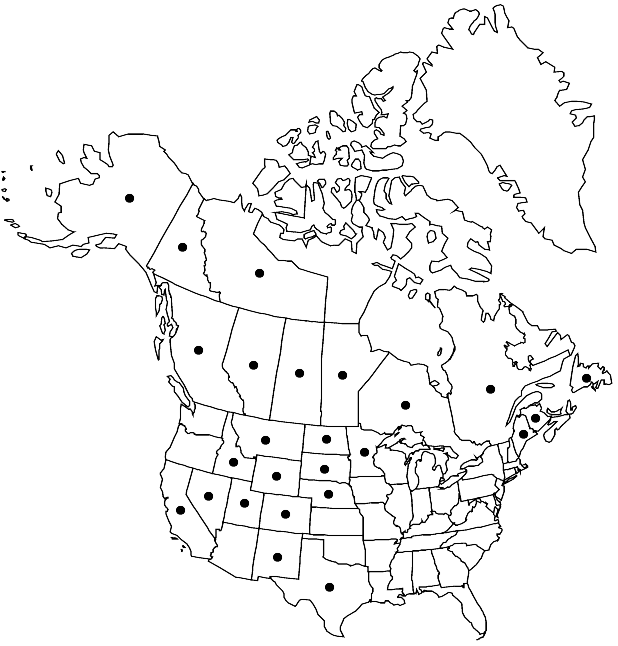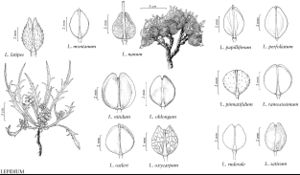Lepidium ramosissimum
Bull. Torrey Bot. Club 26: 124. 1899.
Perennials; puberulent, (trichomes cylindrical). Stems simple from base, erect, branched (several) distally, (0.6–) 1–5.3 (–7.7) dm. Basal leaves (soon withered); not rosulate; petiole 1–4 cm; blade oblanceolate or pinnatifid, 2–5 cm × 8–15 mm, margins (of lobes) entire serrate or dentate. Cauline leaves shortly petiolate or sessile; blade oblanceolate or (distal) linear, (0.6–) 1.2–4.8 (–6) cm × 1–8 (–10) mm, base attenuate to cuneate, not auriculate, margins dentate, (distal) entire, or, rarely, lobed. Racemes slightly elongated in fruit; rachis puberulent, trichomes curved, cylindrical to subclavate. Fruiting pedicels divaricate-ascending to horizontal, straight or recurved, (terete), (1.6–) 2–3.8 (–5) × 0.2–0.3 mm, usually puberulent adaxially, rarely throughout. Flowers: sepals oblong, 0.6–0.9 (–1.1) × 0.3–0.4 mm; petals (absent or rudimentary), white, linear, 0.2–0.8 (–1) × 0.05–0.1 mm, claw absent; stamens 2, median; filaments 0.6–0.9 mm; anthers 0.15–0.2 mm. Fruits elliptic, 2.2–3.2 × 1.7–2.1mm, apically winged, apical notch 0.1–0.3 (–0.4) mm deep; valves thin, smooth, not veined, glabrous or puberulent at least along margin; style usually obsolete, rarely to 0.1 mm, included in apical notch. Seeds oblong, 1.2–1.6 × 0.8–0.9 mm. 2n = 32, 64.
Phenology: Flowering Jun–Aug.
Habitat: Sagebrush communities, pine woodlands, waste grounds, roadsides, railroad embankments, alkaline flats, abandoned fields
Elevation: 0-2900 m
Distribution

Alta., B.C., Man., N.B., Nfld. and Labr. (Nfld.), N.W.T., Ont., Que., Sask., Yukon, Alaska, Calif., Colo., Idaho, Maine, Minn., Mont., Nebr., Nev., N.Mex., N.Dak., S.Dak., Tex., Utah, Wyo., Mexico (Chihuahua)
Discussion
As noted by R. C. Rollins (1993, p. 581), the varieties of Lepidium ramosissimum are “weak at best.” They are based largely on the branching habit and, most importantly, on the presence versus absence of trichomes on the fruit valve. In some collections (e.g., Scoggan 4233, GH; Boivin et al., 13221, GH), both puberulent- and glabrous-fruited forms occur. It is almost certain that the same situation exists not only in other populations of this species, but in other North American Lepidium. It is also clear that some populations might consist entirely of one of the two forms, but it is highly unlikely that this variation has any geographical basis. Therefore, we believe that the separation of varieties solely on the basis of presence or absence of the fruit trichomes is taxonomically meaningless.
We are reluctantly including Lepidium divergens in the synonymy of L. ramosissimum because we have not seen its type; the topotypes that we studied have broadly obovate to suborbicular fruits that appear more at home in the L. densiflorum or L. virginicum complexes.
Selected References
None.
Lower Taxa
"elongated" is not a number."thick" is not a number."dm" is not declared as a valid unit of measurement for this property."dm" is not declared as a valid unit of measurement for this property.
